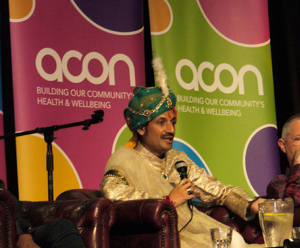
Using royalty for good: Prince Gohil speaks at HIV prevention conference. Photo by acon online via Flickr.
In 1967, Queen Elizabeth II gave royal assent to the Sexual Offences Act. She thereby lifted the ban on homosexual acts between two men that had shackled homosexuals to the fear of blackmail and imprisonment since 1885.
This would provide momentum for the LGBT movement that has since championed the welfare of sexual minorities across much of the Western world. Homosexual acts in private were no longer forbidden and would eventually begin to shed their taboo.
Yet how far was the article that the Queen signed in 1967 applicable to her own family? With one in ten of the British population estimated to be gay, it is easy to recognise the immediate benefits of legal toleration of homosexuality in the private sphere.
Yet when the monarchy, by definition, remains a public institution, how far are members of the Royal family at liberty to live out their sexual identities – a right held for decades by the private subjects whom they continue to represent?
Contradictory Messages
Most modern-day monarchies operate within a legislative limbo. They remain at the very pinnacle of the power hierarchy, symbolic heads of state, yet without the means necessary to implement their will. At times monarchies appear to be at the mercy of their government and citizens. As national communities herald the rights of their LGBT citizens royal heads of state remain ostentatiously mute.
Of course, scandals persist in the wake of royal silence. Stories of kings taking male consorts date back to Edward II’s reign in the 14th century, while King James’ intimacy with the Earl of Lennox was widely acknowledged. More recently, Prince Edward in 1990 was forced to emphatically deny he was gay after being confronted by a deluge of media speculation in Britain and across the Atlantic. He has since married and divorced.
This year, the high profile conviction of Saudi Prince Bin Nasser al Saud for murdering his male servant and lover Bandal Abdulaziz was fraught with revelations of the Prince’s clandestine gay lifestyle – away from prying eyes and regal responsibilities in Riyadh.
While most agree the prince will remain immune from prosecution in Saudi Arabia following his UK gaol term, Bin Nasser al Saud notably attempted to convince the jury of the existence of a girlfriend rather than to profess his innocence. Ironically, it is the Saud family’s absolute decree that homosexuality remains a capital offence that has led one of its members to deny his sexual identity so fervently.
Saudi Arabia is thankfully an exception in LGBT welfare. Yet the presence of a gay prince in a family who aid the demonization of homosexuals in Saudi Arabia’s Wahhabi legal institutions exposes the folly that royalty equates to moral superiority.
Since openly gay politicians occupy the upper echelons of governments in countries such as Britain and Sweden, Alan Duncan and Andreas Carlgren acting as respective examples, it is clear that sexual minorities are present in the powerful classes of constitutional monarchies.
Systematic Obstacles
Yet when monarchs have ‘come out’, what has been the reaction from their subjects? In the cases of an Italian and an Indian prince, who both declared their homosexuality in the early 2000s, the response was negative.
The mother of Indian royal Mavendhra Singh Gohil attempted to disinherit the princeling of his wealth and title after he disclosed his sexuality in 2006. A small mob of traditionalists also burnt his effigy in the streets of Rajpipla.
Gohil has been recognised by the LGBT movement across the world for his promotion of LGBT issues in the Indian public sphere. He is chairman of the Lakshya trust, and has managed to reach out to 18,000 men living with HIV in India’s gay and transgendered communities through his patronage of the charity.
While he laments the hostile reaction by some of his citizens, he feels that he has managed to retain the popularity of the people in light of coming out through his charity work raising awareness for HIV/AIDS.
Likewise, the Italian Prince Jonathan Doria Pamphilj is an active supporter of LGBT rights in conservative Italy. A high-profile court case with his sister Princess Gesine Doria Pamphilj has occupied Italian tabloid coverage.
Princess Gesine, a devout Catholic, has raised issue with the inheritance of their estate to his two adopted children, arguing that it is illegitimate under Italian law. Ironically, Gesine and her brother were both adopted by their mother, the late Princess Orietta, in the early 1960s. Interestingly the Italian tabloid press have reveled in the scandal of the two sibling’s estrangement instead of adopting a condemnatory line against the Prince’s adoption. Rome is interested rather than repulsed by the actions of Prince Jonathan.
Prince Gohil has similarly announced plans to adopt a child in 2008. If he succeeds, he will become the first openly gay man to adopt a child in India, raising very important implications for royal succession.
A Future for Monarchy
Monarchies continue to be predicated upon blood connections. Crowns pass from father to son: dynasties remain in gene pools. When the survival of modern-day monarchies depend upon public popularity, royal adoptions that are considered both illegitimate and morally reprehensible by largely conservative populations such as in Rajpipla, could spell disaster for royal families.
But perhaps monarchies will begin to find that as a new generation of royal subjects, who are increasingly sensible of LGBT issues, come of age, kings and queens will have to alter their public images accordingly.
Queen Elizabeth II has revealed how “like all the best families, we have our share of eccentricities, of impetuous and wayward youngsters and of family disagreements”. Royalty remains at its core a family affair and monarchs should put the welfare of their gay siblings, children and relations before efforts to maintain an illusion of sexual uniformity. That would surely be a display of regal virtue.



